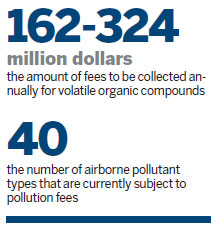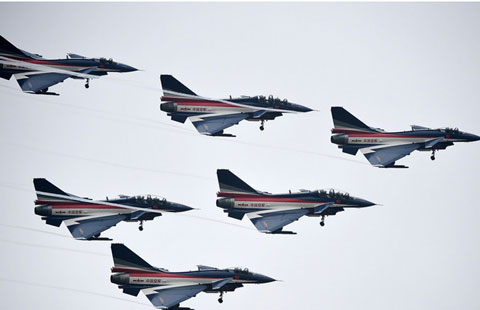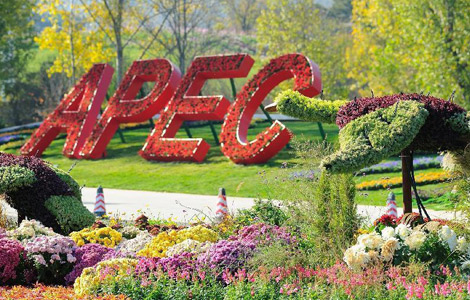New pollutants fee to curb organic chemicals threat
Updated: 2014-08-05 09:30
By Wu Wencong(China Daily)
|
|||||||||

Beijing will become the first Chinese city to impose pollution fees on a new group of airborne pollutants - volatile organic compounds - as early as this month.
"The estimated amount of fees to be collected annually is between 1 billion yuan ($162 million) and 2 billion yuan, about half of which may come from southwest Beijing's Fangshan district, where the city's biggest VOC emitter, Sinopec Beijng Yanshan Co, is located," said Wang Hailin, a researcher from the Beijing Research Institute of Environmental Protection.
Currently, pollution fees are charged for more than 40 types of airborne pollutants, including sulfur dioxide, nitrogen oxide and carbon monoxide. Similarly, VOC is a commonly found airborne pollutant.
As a group of pollutants, including formaldehyde, benzenes and styrene, VOC may pose a threat to the liver, kidneys and nervous system under a certain concentration and prolonged exposure.
The pollutant is mainly generated by the petrochemical industry, organic chemical industry, during the production of plastic products, and in the packaging and printing industry. It enhances the oxidation of the atmosphere, which will facilitate the forming of more pollutants, and is also a premise for the formation of PM2.5 - particulate matter smaller than 2.5 microns in diameter that can penetrate the lungs and seriously harm health.
"China has the largest VOC emissions in the world, and the emissions are also growing quickly," said Yang Jintian, head of the Atmospheric Environment Institute at the Chinese Academy for Environmental Planning.
He said there is no official data for the exact amount of VOC emissions, but they are estimated at about 25 million metric tons a year.

Experts said that compared with the control of sulfur dioxide and particulate matter, the management of VOC remains very weak.
"There is still a lot for us to know about this group of pollutants. There are at least hundreds of types of VOC, some of which we can't even identify yet," said Chai Fahe, vice-president of the Chinese Research Academy of Environmental Sciences.
"That is the reason why we don't take the exact types of VOC into consideration at the first stage of pollution fee collection," said Wang from the Beijing Research Institute of Environmental Protection.
He said the fee to be charged for each ton of VOC will be calculated based on the cost to control it after it is emitted, but the detailed figure has not been released.
However, he said that the standard fee in the United States is about $25 to $30 per ton, while the fee collected for sulfur dioxide in Beijing is 10 yuan per ton. The standard set for VOC is sure to be much higher than 10 yuan per ton, because it is a lot tougher to control VOC than sulfur dioxide, said Wang.
"Once the fee is collected, it will on the one hand encourage companies to reduce VOC emissions, and on the other hand force small companies that don't have the economic and technological strength to reduce emissions to move out of the city, which may help adjust the capital's industrial structure," Wang said.
wuwencong@chinadaily.com.cn
(China Daily USA 11/12/2014 page5)

 All cheers for wedding expos
All cheers for wedding expos
 Magnificent fireworks showed at APEC grand banquet
Magnificent fireworks showed at APEC grand banquet
 Chinese-style outfits designed for participants of APEC
Chinese-style outfits designed for participants of APEC
 Aviation airshow takes off in S China’s Guangdong
Aviation airshow takes off in S China’s Guangdong
 Consul-General Yuan says goodbye to San Francisco
Consul-General Yuan says goodbye to San Francisco
 Kissinger: 'Overcome' issues
Kissinger: 'Overcome' issues
 Peaking for APEC
Peaking for APEC
 Scenery near Yanqi Lake in Beijing
Scenery near Yanqi Lake in Beijing
Most Viewed
Editor's Picks

|

|

|

|

|

|
Today's Top News
Relaxed stroll sets mood for Xi, Obama
All cheers for wedding expos
Night view of Beijing's APEC Meeting site
In pics: Chinese-style outfits designed for participants of APEC
Aviation airshow takes off in S China’s Guangdong
Consul-General Yuan says goodbye to San Francisco
President hails regional trade move
Kissinger: 'Overcome' issues
US Weekly

|

|








